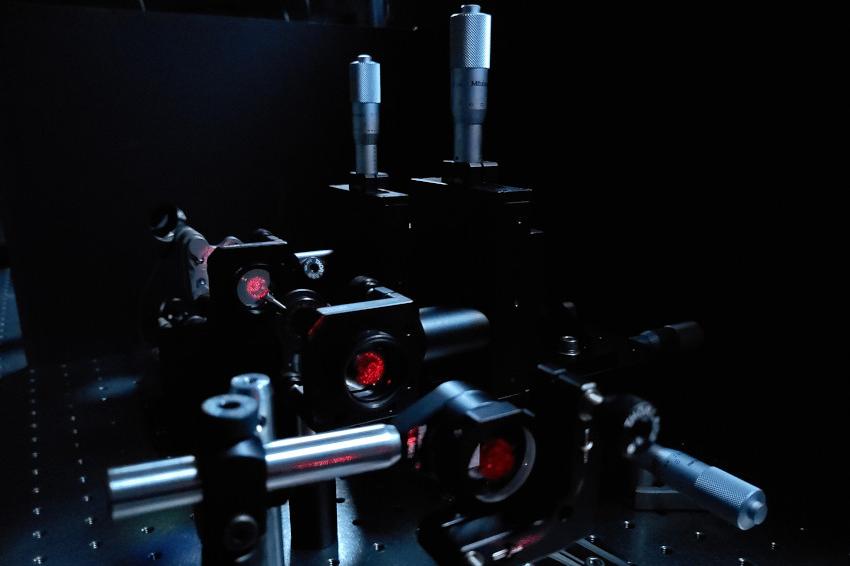A perfect trap for light
Thin device cancels all back-reflections by wave interference
Whether in photosynthesis or in a photovoltaic system: If you want to use light efficiently, you have to absorb it as completely as possible. However, this is difficult if the absorption is to take place in a thin layer of material that normally lets a large part of the light pass through. Now, research teams from TU Wien and from the Hebrew University of Jerusalem (HU) have found a surprising trick that allows a beam of light to be completely absorbed even in the thinnest of layers.
The scientists built a light trap around the thin layer using mirrors and lenses, in which the light beam is steered in a circle and then superimposed on itself – exactly in such a way that the beam of light blocks itself and can no longer leave the system. Thus, the light has no choice but to be absorbed by the thin layer – there is no other way out. This absorption-amplification method is the result of a fruitful collaboration between the two teams: the approach was suggested by Ori Katz from the Hebrew University of Jerusalem and conceptualized with Stefan Rotter from TU Wien; the experiment was carried out in by the lab team in Jerusalem and the theoretical calculations came from the team in Vienna.
“Absorbing light is easy when it hits a solid object,” Stefan Rotter says. “A thick black wool jumper can easily absorb light. But in many technical applications, you only have a thin layer of material available and you want the light to be absorbed exactly in this layer.” There have already been attempts to improve the absorption of materials: For example, the material can be placed between two mirrors. The light is reflected back and forth between the two mirrors, passing through the material each time and thus having a greater chance of being absorbed. However, for this purpose, the mirrors must not be perfect – one of them must be partially transparent, otherwise the light cannot penetrate the area between the two mirrors at all. But this also means that whenever the light hits this partially transparent mirror, some of the light is lost.
To prevent this, it is possible to use the wave properties of light in a sophisticated way. “In our approach, we are able to cancel all back-reflections by wave interference”, noted Ori Katz. Helmut Hörner from TU Wien explained, “in our method, too, the light first falls on a partially transparent mirror. If you simply send a laser beam onto this mirror, it is split into two parts: The larger part is reflected, a smaller part penetrates the mirror.” This part of the light beam that penetrates the mirror is now sent through the absorbing material layer and then returned to the partially transparent mirror with lenses and another mirror.
“The crucial thing is that the length of this path and the position of the optical elements are adjusted in such a way that the returning light beam (and its multiple reflections between the mirrors) exactly cancels out the light beam reflected directly at the first mirror”, said Yevgeny Slobodkin and Gil Weinberg, who built the system in Jerusalem. The two partial beams overlap in such a way that the light blocks itself, so to speak: although the partially transparent mirror alone would actually reflect a large part of the light, this reflection is rendered impossible by the other part of the beam travelling through the system before returning to the partially transparent mirror.
Therefore, the mirror, which used to be partially transparent, now becomes completely transparent for the incident laser beam. This creates a one-way street for the light: the light beam can enter the system, but then it can no longer escape because of the superposition of the reflected portion and the portion guided through the system in a circle. So, the light has no choice but to be absorbed – the entire laser beam is swallowed up by a thin layer that would otherwise allow most of the beam to pass through.
“The system has to be tuned exactly to the wavelength you want to absorb,” explained Rotter. “But apart from that, there are no limiting requirements. The laser beam doesn't have to have a specific shape, it can be more intense in some places than in others – almost perfect absorption is always achieved.” Not even air turbulence and temperature fluctuations can harm the mechanism. This proves that it is a robust effect that promises a wide range of applications – for example, the presented mechanism could even be well suited to perfectly capture light signals that are distorted during transmission through the Earth's atmosphere. The new approach could also be of great practical use for optimally feeding light waves from weak light sources such as distant stars into a detector. (Source: TU Wien)
Link: Advanced Imaging Lab, Applied Physics Dept., The Hebrew University of Jerusalem, Jerusalem, Israel • Institute for Theoretical Physics, Vienna University of Technology (TU Wien), Vienna, Austria







